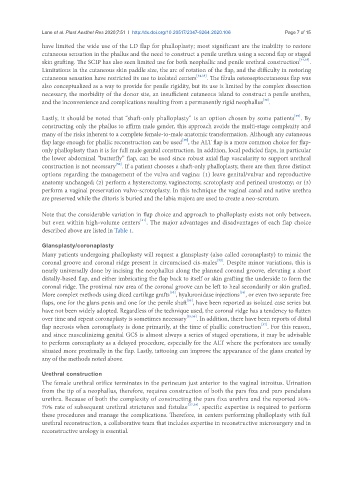Page 591 - Read Online
P. 591
Lane et al. Plast Aesthet Res 2020;7:51 I http://dx.doi.org/10.20517/2347-9264.2020.106 Page 7 of 15
have limited the wide use of the LD flap for phalloplasty; most significant are the inability to restore
cutaneous sensation in the phallus and the need to construct a penile urethra using a second flap or staged
skin grafting. The SCIP has also seen limited use for both neophallic and penile urethral construction [34,35] .
Limitations in the cutaneous skin paddle size, the arc of rotation of the flap, and the difficulty in restoring
cutaneous sensation have restricted its use to isolated centers [34,35] . The fibula osteoseptocutaneous flap was
also conceptualized as a way to provide for penile rigidity, but its use is limited by the complex dissection
necessary, the morbidity of the donor site, an insufficient cutaneous island to construct a penile urethra,
[36]
and the inconvenience and complications resulting from a permanently rigid neophallus .
[29]
Lastly, it should be noted that “shaft-only phalloplasty” is an option chosen by some patients . By
constructing only the phallus to affirm male gender, this approach avoids the multi-stage complexity and
many of the risks inherent to a complete female-to-male anatomic transformation. Although any cutaneous
[49]
flap large enough for phallic reconstruction can be used , the ALT flap is a more common choice for flap-
only phalloplasty than it is for full male genital construction. In addition, local pedicled flaps, in particular
the lower abdominal “butterfly” flap, can be used since robust axial flap vascularity to support urethral
construction is not necessary . If a patient chooses a shaft-only phalloplasty, there are then three distinct
[50]
options regarding the management of the vulva and vagina: (1) leave genital/vulvar and reproductive
anatomy unchanged; (2) perform a hysterectomy, vaginectomy, scrotoplasty and perineal urostomy; or (3)
perform a vaginal preservation vulvo-scrotoplasty. In this technique the vaginal canal and native urethra
are preserved while the clitoris is buried and the labia majora are used to create a neo-scrotum.
Note that the considerable variation in flap choice and approach to phalloplasty exists not only between,
[51]
but even within high-volume centers . The major advantages and disadvantages of each flap choice
described above are listed in Table 1.
Glansplasty/coronaplasty
Many patients undergoing phalloplasty will request a glansplasty (also called coronaplasty) to mimic the
coronal groove and coronal ridge present in circumcised cis-males . Despite minor variations, this is
[52]
nearly universally done by incising the neophallus along the planned coronal groove, elevating a short
distally-based flap, and either imbricating the flap back to itself or skin grafting the underside to form the
coronal ridge. The proximal raw area of the coronal groove can be left to heal secondarily or skin grafted.
[54]
More complex methods using diced cartilage grafts , hyaluronidase injections , or even two separate free
[53]
[55]
flaps, one for the glans penis and one for the penile shaft , have been reported as isolated case series but
have not been widely adopted. Regardless of the technique used, the coronal ridge has a tendency to flatten
over time and repeat coronaplasty is sometimes necessary [55,56] . In addition, there have been reports of distal
[57]
flap necrosis when coronaplasty is done primarily, at the time of phallic construction . For this reason,
and since masculinizing genital GCS is almost always a series of staged operations, it may be advisable
to perform coronaplasty as a delayed procedure, especially for the ALT where the perforators are usually
situated more proximally in the flap. Lastly, tattooing can improve the appearance of the glans created by
any of the methods noted above.
Urethral construction
The female urethral orifice terminates in the perineum just anterior to the vaginal introitus. Urination
from the tip of a neophallus, therefore, requires construction of both the pars fixa and pars pendulans
urethra. Because of both the complexity of constructing the pars fixa urethra and the reported 30%-
70% rate of subsequent urethral strictures and fistulae [27,58] , specific expertise is required to perform
these procedures and manage the complications. Therefore, in centers performing phalloplasty with full
urethral reconstruction, a collaborative team that includes expertise in reconstructive microsurgery and in
reconstructive urology is essential.

